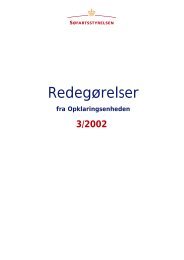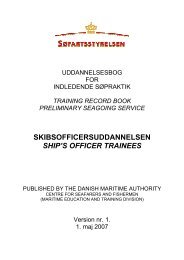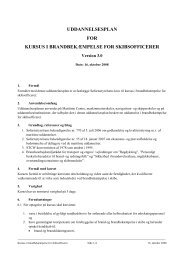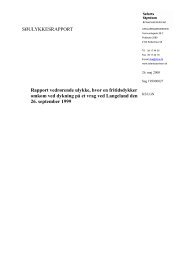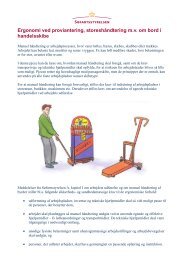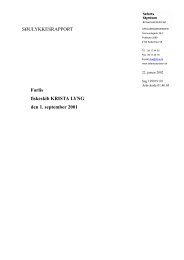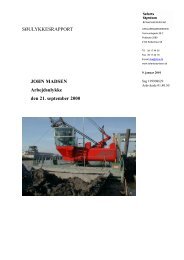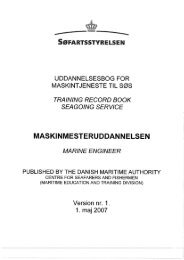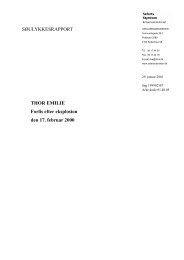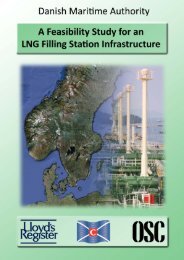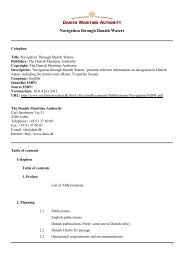Risk Analysis of Sea Traffic in the Area around Bornholm, 2008. - VTT
Risk Analysis of Sea Traffic in the Area around Bornholm, 2008. - VTT
Risk Analysis of Sea Traffic in the Area around Bornholm, 2008. - VTT
- No tags were found...
You also want an ePaper? Increase the reach of your titles
YUMPU automatically turns print PDFs into web optimized ePapers that Google loves.
<strong>Risk</strong> <strong>Analysis</strong> for <strong>Sea</strong> <strong>Traffic</strong> <strong>in</strong> <strong>the</strong> <strong>Area</strong> <strong>around</strong> <strong>Bornholm</strong><br />
5<br />
In <strong>the</strong> process <strong>of</strong> <strong>the</strong> study, two workshops were held, <strong>the</strong> first <strong>in</strong> order to <strong>in</strong>dentify<br />
<strong>the</strong> relevant hazards, <strong>the</strong> second <strong>in</strong> order to validate and discuss <strong>the</strong> results.<br />
The conclusions <strong>of</strong> <strong>the</strong> second workshop served as feedback <strong>in</strong> order to<br />
ref<strong>in</strong>e <strong>the</strong> risk model.<br />
Results: <strong>Bornholm</strong>sgat<br />
The <strong>in</strong>troduction <strong>of</strong> <strong>the</strong> traffic separation scheme <strong>in</strong> <strong>the</strong> <strong>Bornholm</strong>sgat has had a<br />
clear effect upon navigational risk. When compar<strong>in</strong>g <strong>the</strong> situation <strong>in</strong> 2005 and<br />
that <strong>in</strong> 2006, it appears that expected accident costs fell from DKK 29.0 million<br />
(€3.9 million) to DKK 18.3 million (€2.5 million) per year. This corresponds to<br />
a decrease by DKK 10.7 million per year or 37 percent.<br />
The largest part <strong>of</strong> this effect is due to a strong reduction <strong>in</strong> head-on collision<br />
risk. This is an obvious effect <strong>of</strong> <strong>the</strong> traffic separation which provides one sail<strong>in</strong>g<br />
lane for each traffic direction. Besides, cross<strong>in</strong>g collisions were reduced,<br />
although it can be expected that <strong>the</strong> actual reduction is even greater. The new<br />
traffic separation scheme forces traffic from Øresund and from Kadetrenden to<br />
merge <strong>in</strong> a designated cautionary area, which makes o<strong>the</strong>r ships’ behaviour<br />
more predictable. However, this effect is not <strong>in</strong>cluded <strong>in</strong> <strong>the</strong> physically-based<br />
collision model. Ground<strong>in</strong>gs are equally reduced, but <strong>the</strong>ir contribution to total<br />
risk is limited due to <strong>the</strong>ir comparatively small consequences.<br />
Accident costs are dom<strong>in</strong>ated by clean-up costs due to oil spillage. This dom<strong>in</strong>ance<br />
is clear <strong>in</strong> <strong>the</strong> <strong>Bornholm</strong>sgat itself, where oil tankers are a significant<br />
traffic contribution, while be<strong>in</strong>g weak <strong>in</strong> <strong>the</strong> rema<strong>in</strong><strong>in</strong>g waters surround<strong>in</strong>g<br />
<strong>Bornholm</strong>.<br />
As a result, it can be said that <strong>the</strong> <strong>in</strong>troduction <strong>of</strong> <strong>the</strong> traffic separation scheme<br />
has reduced navigational risk significantly.<br />
Results: Gdańsk<br />
Bay traffic<br />
As mentioned, it was conceived to divert vessels sail<strong>in</strong>g to and from Gdańsk,<br />
Kal<strong>in</strong><strong>in</strong>grad and Klaipėda to different routes, <strong>in</strong> dependence <strong>of</strong> <strong>the</strong>ir respective<br />
draught. The correspond<strong>in</strong>g traffic volume is low compared to that <strong>in</strong> <strong>the</strong> <strong>Bornholm</strong>sgat,<br />
which means that <strong>the</strong> absolute accident risk reduction is relatively<br />
low, too. Accident costs can be expected to drop from DKK 2.34 million to<br />
DKK 2.19 million per year, <strong>in</strong> <strong>the</strong> areas north-east and south <strong>of</strong> <strong>Bornholm</strong>,<br />
where <strong>the</strong> traffic diversion would be implemented. This corresponds to a drop<br />
by 6 percent.<br />
When <strong>in</strong>clud<strong>in</strong>g <strong>the</strong> heavily frequented, but only marg<strong>in</strong>ally affected <strong>Bornholm</strong>sgat<br />
<strong>in</strong> <strong>the</strong> consideration, total expected accident costs fall from currently<br />
DKK 18.3 million (€2.47 million) to DKK 18.0 million (€2.42 million) per<br />
year. This decrease by DKK 285,000 (€38,000) per year corresponds to a reduction<br />
by 2%.<br />
However, <strong>the</strong>se numbers reflect only <strong>the</strong> accident costs, while ignor<strong>in</strong>g direct<br />
costs, i.e. ship operation costs and externalities. They, too, are <strong>in</strong>fluenced because<br />
ships would on average be forced to take slightly longer routes than presently.<br />
These costs would rise by DKK 4.00 million (€537.000) per year, which<br />
clearly outbalances <strong>the</strong> reduction <strong>in</strong> accident costs. Out <strong>of</strong> <strong>the</strong>se 4 millions,<br />
P:\65775A\3_Pdoc\DOC\P-65775A ma<strong>in</strong> report f<strong>in</strong>al corr prepared for PDF.DOC<br />
.



